warning light LINCOLN NAVIGATOR 2016 Owners Manual
[x] Cancel search | Manufacturer: LINCOLN, Model Year: 2016, Model line: NAVIGATOR, Model: LINCOLN NAVIGATOR 2016Pages: 419, PDF Size: 3.59 MB
Page 5 of 419
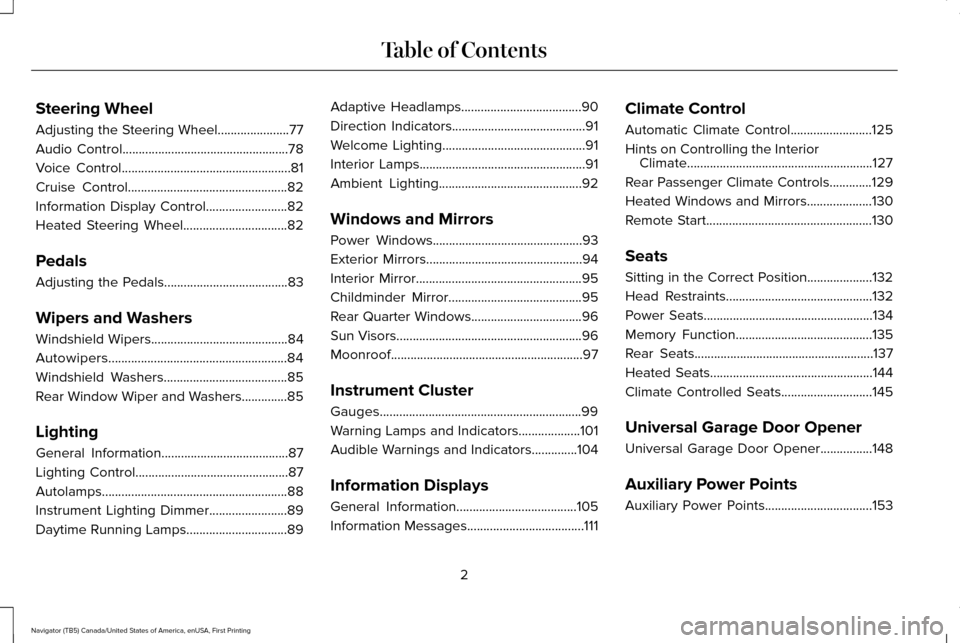
Steering Wheel
Adjusting the Steering Wheel......................77
Audio Control...................................................78
Voice Control
....................................................81
Cruise Control.................................................82
Information Display Control
.........................82
Heated Steering Wheel
................................82
Pedals
Adjusting the Pedals
......................................83
Wipers and Washers
Windshield Wipers
..........................................84
Autowipers.......................................................84
Windshield Washers
......................................85
Rear Window Wiper and Washers..............85
Lighting
General Information
.......................................87
Lighting Control
...............................................87
Autolamps.........................................................88
Instrument Lighting Dimmer........................89
Daytime Running Lamps...............................89 Adaptive Headlamps
.....................................90
Direction Indicators.........................................91
Welcome Lighting
............................................91
Interior Lamps
...................................................91
Ambient Lighting
............................................92
Windows and Mirrors
Power Windows
..............................................93
Exterior Mirrors
................................................94
Interior Mirror...................................................95
Childminder Mirror
.........................................95
Rear Quarter Windows
..................................96
Sun Visors
.........................................................96
Moonroof...........................................................97
Instrument Cluster
Gauges..............................................................99
Warning Lamps and Indicators...................101
Audible Warnings and Indicators
..............104
Information Displays
General Information.....................................105
Information Messages....................................111 Climate Control
Automatic Climate Control
.........................125
Hints on Controlling the Interior Climate.........................................................127
Rear Passenger Climate Controls.............129
Heated Windows and Mirrors....................130
Remote Start
...................................................130
Seats
Sitting in the Correct Position....................132
Head Restraints.............................................132
Power Seats....................................................134
Memory Function
..........................................135
Rear Seats
.......................................................137
Heated Seats
..................................................144
Climate Controlled Seats
............................145
Universal Garage Door Opener
Universal Garage Door Opener
................148
Auxiliary Power Points
Auxiliary Power Points.................................153
2
Navigator (TB5) Canada/United States of America, enUSA, First Printing Table of Contents
Page 12 of 419
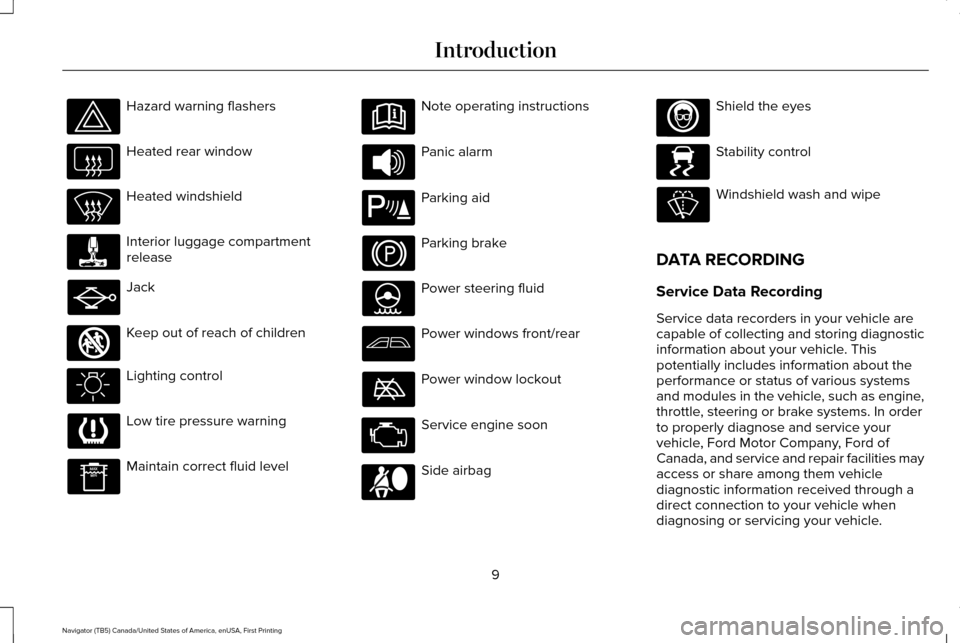
Hazard warning flashers
Heated rear window
Heated windshield
Interior luggage compartment
release
Jack
Keep out of reach of children
Lighting control
Low tire pressure warning
Maintain correct fluid level Note operating instructions
Panic alarm
Parking aid
Parking brake
Power steering fluid
Power windows front/rear
Power window lockout
Service engine soon
Side airbag Shield the eyes
Stability control
Windshield wash and wipe
DATA RECORDING
Service Data Recording
Service data recorders in your vehicle are
capable of collecting and storing diagnostic
information about your vehicle. This
potentially includes information about the
performance or status of various systems
and modules in the vehicle, such as engine,
throttle, steering or brake systems. In order
to properly diagnose and service your
vehicle, Ford Motor Company, Ford of
Canada, and service and repair facilities may
access or share among them vehicle
diagnostic information received through a
direct connection to your vehicle when
diagnosing or servicing your vehicle.
9
Navigator (TB5) Canada/United States of America, enUSA, First Printing Introduction E161353 E139213 E167012 E138639
Page 16 of 419
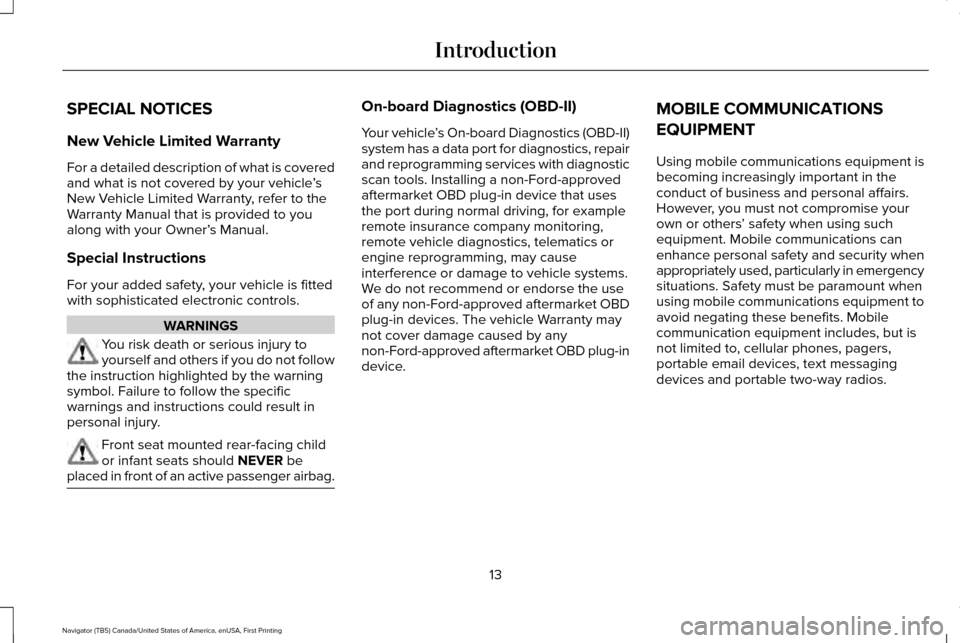
SPECIAL NOTICES
New Vehicle Limited Warranty
For a detailed description of what is covered
and what is not covered by your vehicle
’s
New Vehicle Limited Warranty, refer to the
Warranty Manual that is provided to you
along with your Owner’ s Manual.
Special Instructions
For your added safety, your vehicle is fitted
with sophisticated electronic controls. WARNINGS
You risk death or serious injury to
yourself and others if you do not follow
the instruction highlighted by the warning
symbol. Failure to follow the specific
warnings and instructions could result in
personal injury. Front seat mounted rear-facing child
or infant seats should NEVER be
placed in front of an active passenger airbag. On-board Diagnostics (OBD-II)
Your vehicle
’s On-board Diagnostics (OBD-II)
system has a data port for diagnostics, repair
and reprogramming services with diagnostic
scan tools. Installing a non-Ford-approved
aftermarket OBD plug-in device that uses
the port during normal driving, for example
remote insurance company monitoring,
remote vehicle diagnostics, telematics or
engine reprogramming, may cause
interference or damage to vehicle systems.
We do not recommend or endorse the use
of any non-Ford-approved aftermarket OBD
plug-in devices. The vehicle Warranty may
not cover damage caused by any
non-Ford-approved aftermarket OBD plug-in
device. MOBILE COMMUNICATIONS
EQUIPMENT
Using mobile communications equipment is
becoming increasingly important in the
conduct of business and personal affairs.
However, you must not compromise your
own or others
’ safety when using such
equipment. Mobile communications can
enhance personal safety and security when
appropriately used, particularly in emergency
situations. Safety must be paramount when
using mobile communications equipment to
avoid negating these benefits. Mobile
communication equipment includes, but is
not limited to, cellular phones, pagers,
portable email devices, text messaging
devices and portable two-way radios.
13
Navigator (TB5) Canada/United States of America, enUSA, First Printing Introduction
Page 24 of 419
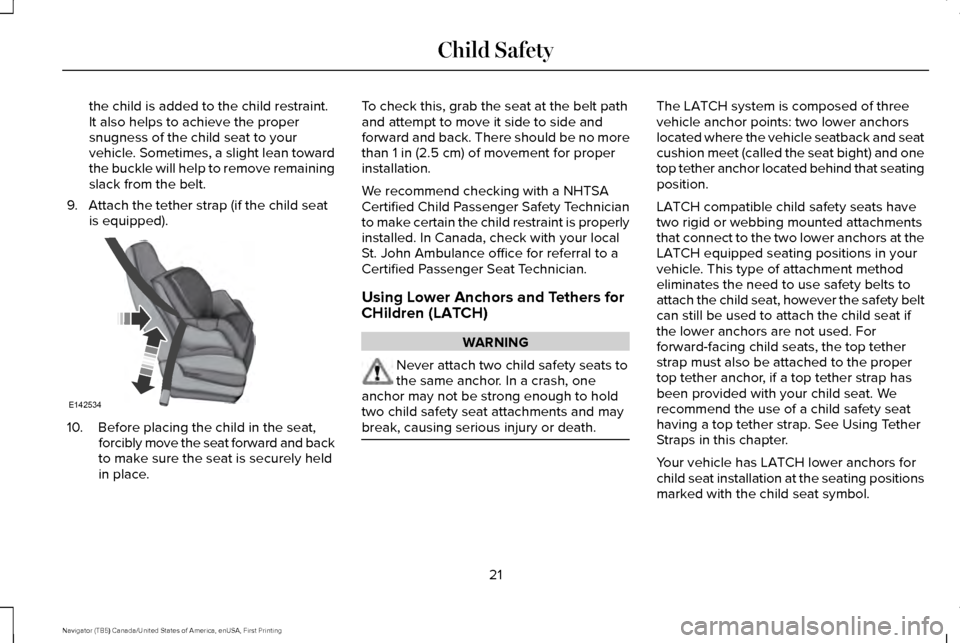
the child is added to the child restraint.
It also helps to achieve the proper
snugness of the child seat to your
vehicle. Sometimes, a slight lean toward
the buckle will help to remove remaining
slack from the belt.
9. Attach the tether strap (if the child seat is equipped). 10. Before placing the child in the seat,
forcibly move the seat forward and back
to make sure the seat is securely held
in place. To check this, grab the seat at the belt path
and attempt to move it side to side and
forward and back. There should be no more
than 1 in (2.5 cm) of movement for proper
installation.
We recommend checking with a NHTSA
Certified Child Passenger Safety Technician
to make certain the child restraint is properly
installed. In Canada, check with your local
St. John Ambulance office for referral to a
Certified Passenger Seat Technician.
Using Lower Anchors and Tethers for
CHildren (LATCH) WARNING
Never attach two child safety seats to
the same anchor. In a crash, one
anchor may not be strong enough to hold
two child safety seat attachments and may
break, causing serious injury or death. The LATCH system is composed of three
vehicle anchor points: two lower anchors
located where the vehicle seatback and seat
cushion meet (called the seat bight) and one
top tether anchor located behind that seating
position.
LATCH compatible child safety seats have
two rigid or webbing mounted attachments
that connect to the two lower anchors at the
LATCH equipped seating positions in your
vehicle. This type of attachment method
eliminates the need to use safety belts to
attach the child seat, however the safety belt
can still be used to attach the child seat if
the lower anchors are not used. For
forward-facing child seats, the top tether
strap must also be attached to the proper
top tether anchor, if a top tether strap has
been provided with your child seat. We
recommend the use of a child safety seat
having a top tether strap. See Using Tether
Straps in this chapter.
Your vehicle has LATCH lower anchors for
child seat installation at the seating positions
marked with the child seat symbol.
21
Navigator (TB5) Canada/United States of America, enUSA, First Printing Child SafetyE142534
Page 36 of 419
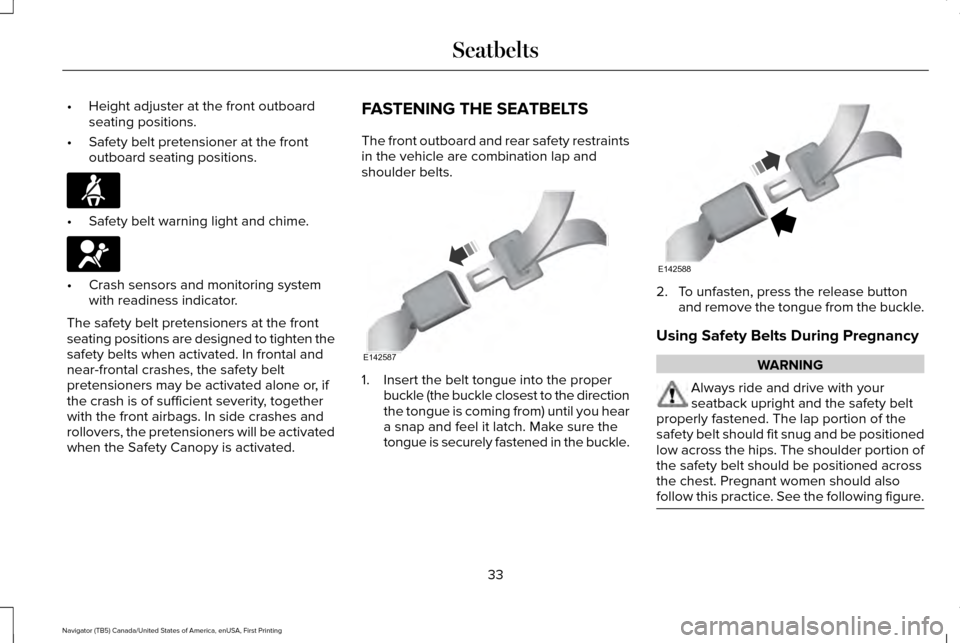
•
Height adjuster at the front outboard
seating positions.
• Safety belt pretensioner at the front
outboard seating positions. •
Safety belt warning light and chime. •
Crash sensors and monitoring system
with readiness indicator.
The safety belt pretensioners at the front
seating positions are designed to tighten the
safety belts when activated. In frontal and
near-frontal crashes, the safety belt
pretensioners may be activated alone or, if
the crash is of sufficient severity, together
with the front airbags. In side crashes and
rollovers, the pretensioners will be activated
when the Safety Canopy is activated. FASTENING THE SEATBELTS
The front outboard and rear safety restraints
in the vehicle are combination lap and
shoulder belts.
1. Insert the belt tongue into the proper
buckle (the buckle closest to the direction
the tongue is coming from) until you hear
a snap and feel it latch. Make sure the
tongue is securely fastened in the buckle. 2. To unfasten, press the release button
and remove the tongue from the buckle.
Using Safety Belts During Pregnancy WARNING
Always ride and drive with your
seatback upright and the safety belt
properly fastened. The lap portion of the
safety belt should fit snug and be positioned
low across the hips. The shoulder portion of
the safety belt should be positioned across
the chest. Pregnant women should also
follow this practice. See the following figure. 33
Navigator (TB5) Canada/United States of America, enUSA, First Printing Seatbelts E142587 E142588
Page 37 of 419
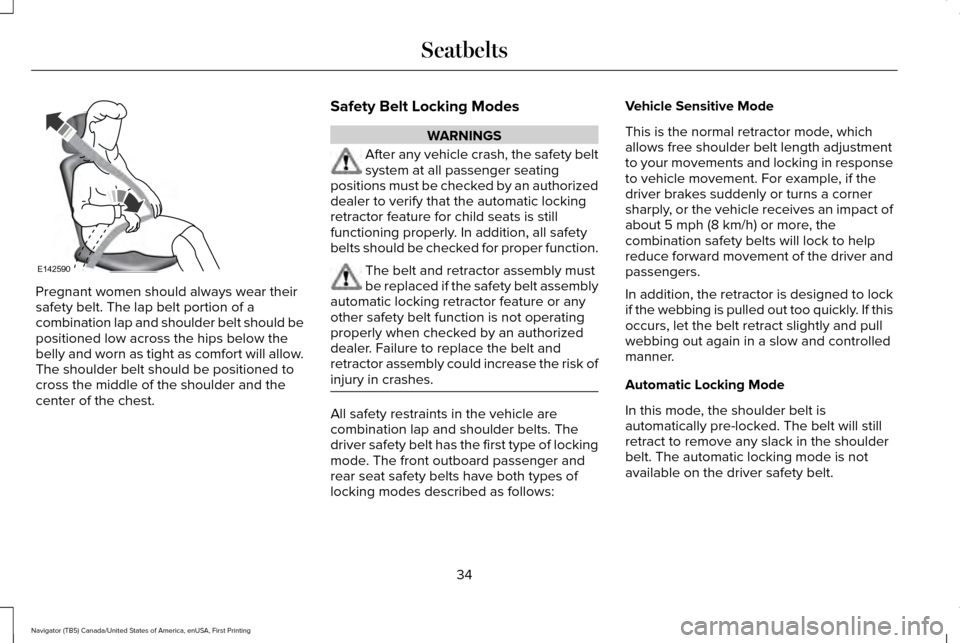
Pregnant women should always wear their
safety belt. The lap belt portion of a
combination lap and shoulder belt should be
positioned low across the hips below the
belly and worn as tight as comfort will allow.
The shoulder belt should be positioned to
cross the middle of the shoulder and the
center of the chest.
Safety Belt Locking Modes WARNINGS
After any vehicle crash, the safety belt
system at all passenger seating
positions must be checked by an authorized
dealer to verify that the automatic locking
retractor feature for child seats is still
functioning properly. In addition, all safety
belts should be checked for proper function. The belt and retractor assembly must
be replaced if the safety belt assembly
automatic locking retractor feature or any
other safety belt function is not operating
properly when checked by an authorized
dealer. Failure to replace the belt and
retractor assembly could increase the risk of
injury in crashes. All safety restraints in the vehicle are
combination lap and shoulder belts. The
driver safety belt has the first type of locking
mode. The front outboard passenger and
rear seat safety belts have both types of
locking modes described as follows:Vehicle Sensitive Mode
This is the normal retractor mode, which
allows free shoulder belt length adjustment
to your movements and locking in response
to vehicle movement. For example, if the
driver brakes suddenly or turns a corner
sharply, or the vehicle receives an impact of
about 5 mph (8 km/h) or more, the
combination safety belts will lock to help
reduce forward movement of the driver and
passengers.
In addition, the retractor is designed to lock
if the webbing is pulled out too quickly. If this
occurs, let the belt retract slightly and pull
webbing out again in a slow and controlled
manner.
Automatic Locking Mode
In this mode, the shoulder belt is
automatically pre-locked. The belt will still
retract to remove any slack in the shoulder
belt. The automatic locking mode is not
available on the driver safety belt.
34
Navigator (TB5) Canada/United States of America, enUSA, First Printing SeatbeltsE142590
Page 40 of 419
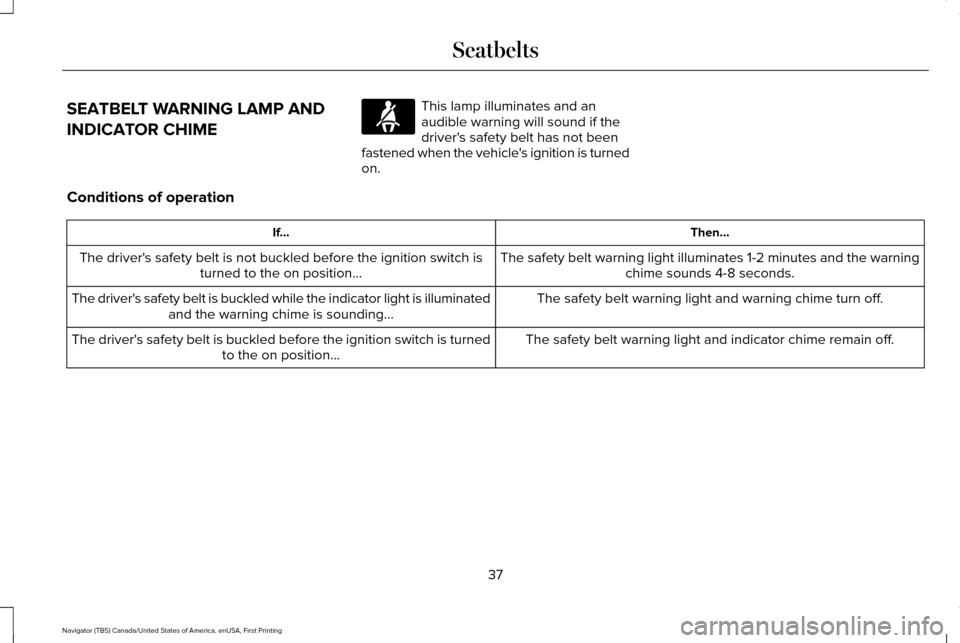
SEATBELT WARNING LAMP AND
INDICATOR CHIME This lamp illuminates and an
audible warning will sound if the
driver's safety belt has not been
fastened when the vehicle's ignition is turned
on.
Conditions of operation Then...
If...
The safety belt warning light illuminates 1-2 minutes and the warningchime sounds 4-8 seconds.
The driver's safety belt is not buckled before the ignition switch is
turned to the on position...
The safety belt warning light and warning chime turn off.
The driver's safety belt is buckled while the indicator light is illuminated
and the warning chime is sounding...
The safety belt warning light and indicator chime remain off.
The driver's safety belt is buckled before the ignition switch is turned
to the on position...
37
Navigator (TB5) Canada/United States of America, enUSA, First Printing Seatbelts
Page 41 of 419
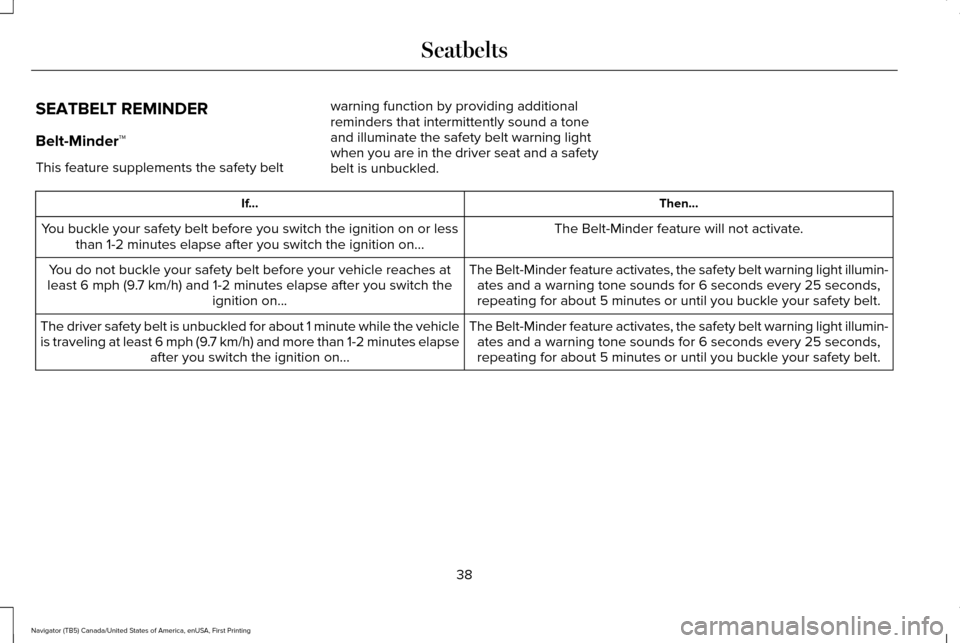
SEATBELT REMINDER
Belt-Minder™
This feature supplements the safety belt
warning function by providing additional
reminders that intermittently sound a tone
and illuminate the safety belt warning light
when you are in the driver seat and a safety
belt is unbuckled. Then...
If...
The Belt-Minder feature will not activate.
You buckle your safety belt before you switch the ignition on or less
than 1-2 minutes elapse after you switch the ignition on...
The Belt-Minder feature activates, the safety belt warning light illumin\
-ates and a warning tone sounds for 6 seconds every 25 seconds,
repeating for about 5 minutes or until you buckle your safety belt.
You do not buckle your safety belt before your vehicle reaches at
least 6 mph (9.7 km/h) and 1-2 minutes elapse after you switch the ignition on...
The Belt-Minder feature activates, the safety belt warning light illumin\
-ates and a warning tone sounds for 6 seconds every 25 seconds,
repeating for about 5 minutes or until you buckle your safety belt.
The driver safety belt is unbuckled for about 1 minute while the vehicle\
is traveling at least 6 mph (9.7 km/h) and more than 1-2 minutes elapse
after you switch the ignition on...
38
Navigator (TB5) Canada/United States of America, enUSA, First Printing Seatbelts
Page 42 of 419
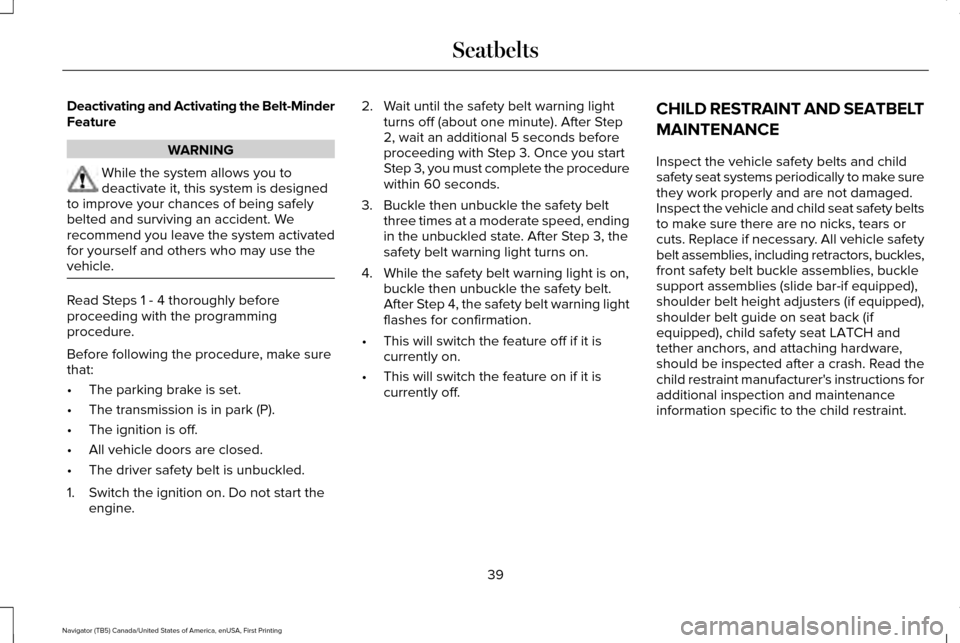
Deactivating and Activating the Belt-Minder
Feature
WARNING
While the system allows you to
deactivate it, this system is designed
to improve your chances of being safely
belted and surviving an accident. We
recommend you leave the system activated
for yourself and others who may use the
vehicle. Read Steps 1 - 4 thoroughly before
proceeding with the programming
procedure.
Before following the procedure, make sure
that:
•
The parking brake is set.
• The transmission is in park (P).
• The ignition is off.
• All vehicle doors are closed.
• The driver safety belt is unbuckled.
1. Switch the ignition on. Do not start the engine. 2. Wait until the safety belt warning light
turns off (about one minute). After Step
2, wait an additional 5 seconds before
proceeding with Step 3. Once you start
Step 3, you must complete the procedure
within 60 seconds.
3. Buckle then unbuckle the safety belt three times at a moderate speed, ending
in the unbuckled state. After Step 3, the
safety belt warning light turns on.
4. While the safety belt warning light is on, buckle then unbuckle the safety belt.
After Step 4, the safety belt warning light
flashes for confirmation.
• This will switch the feature off if it is
currently on.
• This will switch the feature on if it is
currently off. CHILD RESTRAINT AND SEATBELT
MAINTENANCE
Inspect the vehicle safety belts and child
safety seat systems periodically to make sure
they work properly and are not damaged.
Inspect the vehicle and child seat safety belts
to make sure there are no nicks, tears or
cuts. Replace if necessary. All vehicle safety
belt assemblies, including retractors, buckles,
front safety belt buckle assemblies, buckle
support assemblies (slide bar-if equipped),
shoulder belt height adjusters (if equipped),
shoulder belt guide on seat back (if
equipped), child safety seat LATCH and
tether anchors, and attaching hardware,
should be inspected after a crash. Read the
child restraint manufacturer's instructions for
additional inspection and maintenance
information specific to the child restraint.
39
Navigator (TB5) Canada/United States of America, enUSA, First Printing Seatbelts
Page 45 of 419
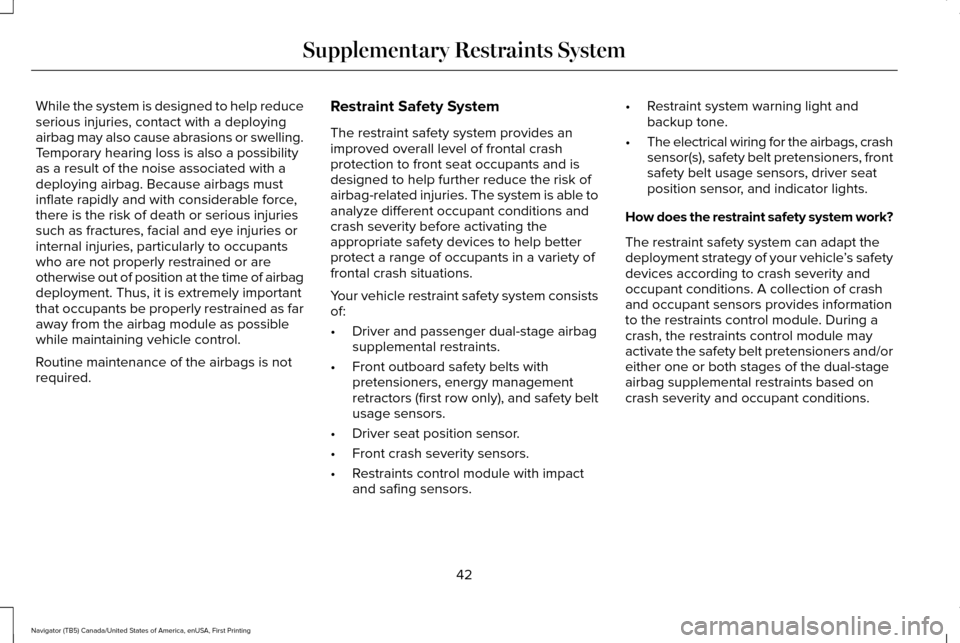
While the system is designed to help reduce
serious injuries, contact with a deploying
airbag may also cause abrasions or swelling.
Temporary hearing loss is also a possibility
as a result of the noise associated with a
deploying airbag. Because airbags must
inflate rapidly and with considerable force,
there is the risk of death or serious injuries
such as fractures, facial and eye injuries or
internal injuries, particularly to occupants
who are not properly restrained or are
otherwise out of position at the time of airbag
deployment. Thus, it is extremely important
that occupants be properly restrained as far
away from the airbag module as possible
while maintaining vehicle control.
Routine maintenance of the airbags is not
required.
Restraint Safety System
The restraint safety system provides an
improved overall level of frontal crash
protection to front seat occupants and is
designed to help further reduce the risk of
airbag-related injuries. The system is able to
analyze different occupant conditions and
crash severity before activating the
appropriate safety devices to help better
protect a range of occupants in a variety of
frontal crash situations.
Your vehicle restraint safety system consists
of:
•
Driver and passenger dual-stage airbag
supplemental restraints.
• Front outboard safety belts with
pretensioners, energy management
retractors (first row only), and safety belt
usage sensors.
• Driver seat position sensor.
• Front crash severity sensors.
• Restraints control module with impact
and safing sensors. •
Restraint system warning light and
backup tone.
• The electrical wiring for the airbags, crash
sensor(s), safety belt pretensioners, front
safety belt usage sensors, driver seat
position sensor, and indicator lights.
How does the restraint safety system work?
The restraint safety system can adapt the
deployment strategy of your vehicle ’s safety
devices according to crash severity and
occupant conditions. A collection of crash
and occupant sensors provides information
to the restraints control module. During a
crash, the restraints control module may
activate the safety belt pretensioners and/or
either one or both stages of the dual-stage
airbag supplemental restraints based on
crash severity and occupant conditions.
42
Navigator (TB5) Canada/United States of America, enUSA, First Printing Supplementary Restraints System